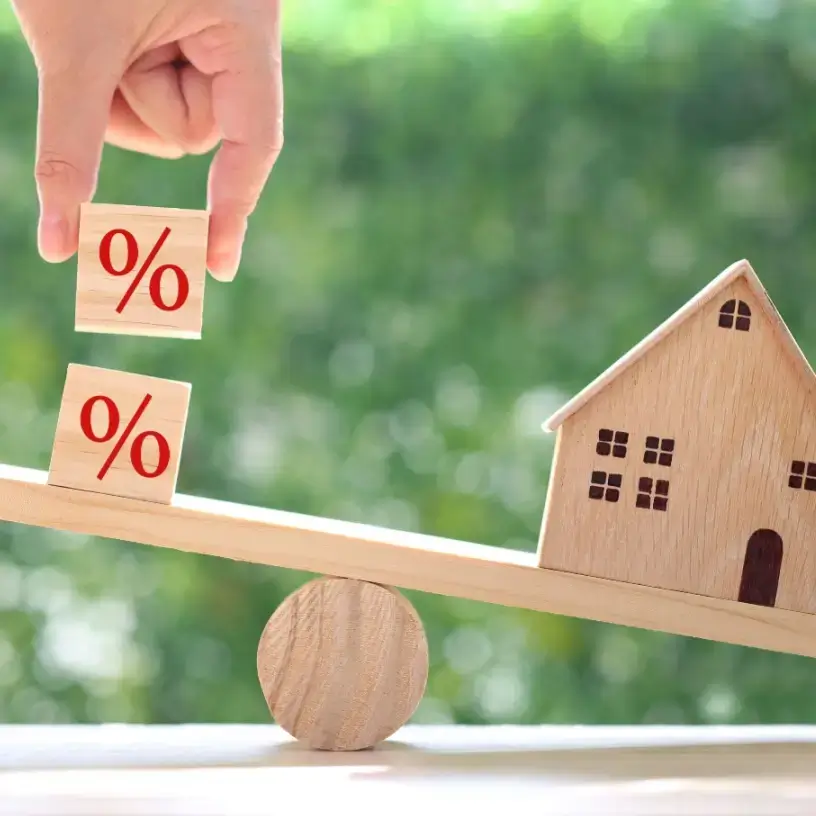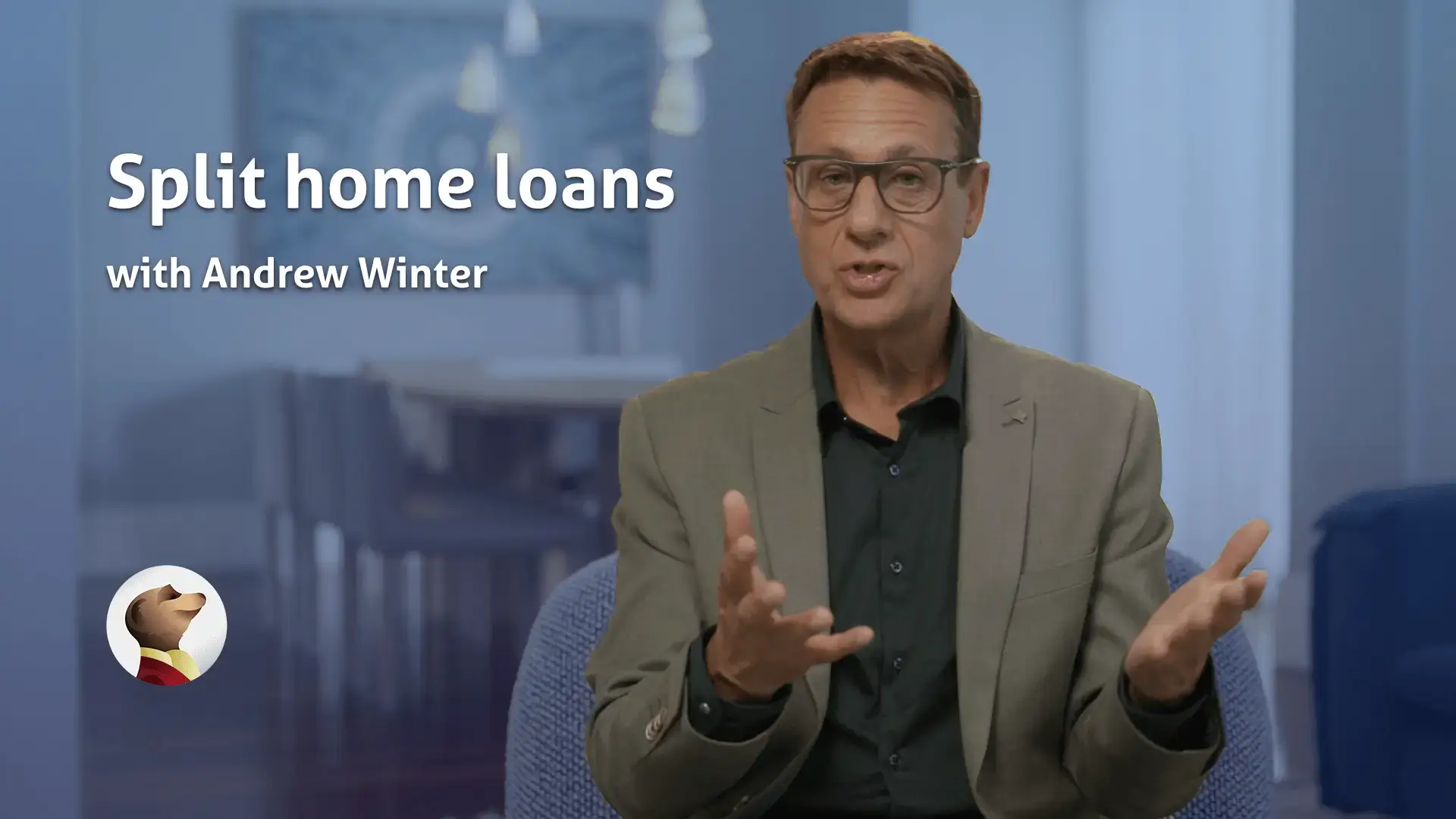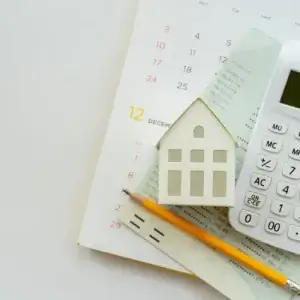Home / Home Loans / What is a split home loa…




Key takeaways
- A split home loan is a type of home loan that has two components: one with a fixed interest rate and one with a variable interest rate.
- This allows you to reap the benefits of both types of interest rate, however it also exposes you to the risks of both rate types.
- It doesn’t have to be a 50/50 split of the principal – you can typically choose the relative size of each component.
- It’s wise to weigh up the pros and cons of both rate types and figure out how you want your home loan split up.
What is a split home loan?
Considering taking out a split rate home loan? Selling Houses Australia host Andrew Winter has tips and advice for you.



Hi, I’m Andrew Winter, host of Selling Houses Australia.
The process of getting a home loan and buying a home usually requires a certain strength of will;
the ability to make a tough decision and stick with it.
But funnily enough, if you’re having trouble deciding between a fixed or a variable rate,
the good news is that you don’t have to! Most lenders offer something called a split rate home loan,
which is essentially a best-of-both-worlds solution to
the question of fixed vs variable rates. A split rate home loan lets you divide your home loan
into two components, and then slap a variable rate on one, and a fixed rate on the other.
The relative size of the components will be up to you, so you could go with 80% fixed and
20% variable, or 60% variable and 40% fixed – the world’s your oyster here!
Splitting your home loan in this way gives you the peace of mind afforded by a fixed rate,
as well as the flexibility and ability to make additional repayments that you
get with a variable rate home loan. That flexibility can work against you
though – remember that a variable rate can go up as well as down, so a split rate home loan still
leaves you susceptible to the risk of a rate rise. But, the beautiful thing about a split rate home loan
is that if rates do go up, your fixed rate component will just stay the way it is,
meaning you’re not paying extra interest on your entire home loan – just the variable rate component.
However, just like with a regular fixed rate home loan, you’ll only get up to five
years of fixed repayments before your entire home loan becomes a variable rate home loan.
It’s also worth noting that you’ll likely pay more in fees on a split rate home loan.
If you are asking a lender to maintain two separate home loan accounts for you,
they may decide to charge you two sets of account-keeping fees – but be sure to check
with your lender to see how they’d handle this. And that’s what makes it vitally important to
compare your options before you sign up for a home loan – if you don’t compare, how are you meant to
know whether your home loan’s a good deal or not? Compare the Market’s new home loan comparison tool
lets you compare your home loan options on rates, features, fees, and more,
so that you can make an informed choice when it comes time to get a home loan.
So, what are you still doing here? Compare home loans today, with Compare the Market.
Why choose a split rate home loan?
- If you’re torn between fixed rate and variable rate home loans, a split home loan could be a ‘best of both worlds’ home loan type.
- A fixed rate component gives you a measure of protection against interest rate increases, whereas a variable rate component lets you benefit from rate cuts and generally the flexibility of unlimited extra repayments.
Comparing split rate home loans
When comparing different split rate home loan products, you’ll want to keep a few different factors in mind:
- Both comparison rates – Two different interest rates means two different comparison rates, so you’ll need to make sure that both of the rates on any given split home loan product are competitive.
- Permitted split proportions – Depending on the lender, a split loan product may impose minimum or maximum proportion amounts. Be sure that any product you’re considering allows the split proportions you’re looking for.
- Features and fees – Make sure you’re getting value in the form of the features you want or need and competitive fees.
Expert tips for split home loans
While split rate home loans can make for a great home loan solution, it’s important to understand the ramifications of choosing a split home loan and how your loan balance is divided up. Our General Manager of Money, Stephen Zeller, has some tips for anyone considering a split rate home loan.

You can split your loan for investment purposes
Not all borrowers know that you can also split investment home loans, which can come in handy for property investors with an existing investment home loan looking to borrow money against their rental property.
Consider the impact of offset accounts
Some lenders may restrict how many offset accounts a customer can set up, regardless of how many loan splits they have. If you’re thinking of having multiple offset accounts set up across multiple loan splits, be sure to research any possible restrictions before applying. Our expert mortgage brokers can help you uncover the various lenders that offer multiple offset arrangements and how they apply to split loans.
Watch out for the fees
Depending on your lender, two accounts could potentially mean two sets of monthly fees. If the lender in question charges a monthly account-keeping fee on their home loan accounts, check to see if you’ll be charged twice under a split home loan arrangement.
Split rate home loans explained
What is a split home loan?

A split rate home loan is a type of home loan in which the principal (i.e. loan amount) is divided up and placed into two loan accounts, one with a fixed interest rate attached to it and the other with a variable interest rate.
These two components form the same overall home loan but are treated like separate loans for the purpose of calculating your total interest charges and fees. It’s worth noting that your loan-to-value ratio (LVR) will still be based on the total size of the loan, rather than on its two individual components.
As with standard fixed rate home loans, the fixed rate period on a split loan will generally only last for one to five years, after which this component of the principal will typically revert to a standard variable rate unless you refinance or otherwise arrange your loan differently.
Split rate home loans are a potentially attractive option for risk-averse homebuyers. By fixing a portion of the loan and leaving the rest on a variable home loan interest rate, you stand to potentially benefit from an interest rate decrease and are also better guarded against the impact of an interest rate rise.
What features can I get on a split rate home loan?
You’ll typically find that split rate home loans can offer the same features as those available on fixed and variable rate home loans, including:
- An offset account
- A redraw facility
- Flexible loan repayment options
- The option to take a repayment holiday.
Be sure to shop around to find a home loan arrangement that offers features that benefit you. You can also talk to one of our expert mortgage brokers.
What are the pros and cons of a split home loan?
Pro: The fixed portion can afford you a measure of budgeting security
By having a fixed interest rate on part of your home loan, you’ll have a much better idea of what your regular home loan repayments will look like. While it will still potentially fluctuate overall due to the variable component of your home loan, the potential for fluctuation in either direction is smaller than it would be on a fully-fledged variable rate home loan.
The security afforded by the fixed rate term can be invaluable for those on strict budgets, or who just want as much peace of mind as possible when it comes to their home loan repayments.
Pro: If interest rates drop, you may be charged less interest on your split loan’s variable portion
If the official cash rate goes down, most lenders typically follow suit by dropping the rates on their variable rate loan products. For those on split home loans, this would mean a dip in the amount of interest they’re paying on the variable rate component of their home loan. This would in turn make for smaller weekly, fortnightly or monthly repayments.
Bear in mind, though, that the choice to pass on an interest rate cut rests solely with your lender, and you won’t benefit from a cash rate reduction if your lender chooses not to pass it on in some respect to customers.
Pro: You can generally make penalty-free extra repayments on your variable portion
If you’re the proactive type and (when possible) like to pay more than the minimum amount towards your home loan, you’ll be pleased to know this is generally available with split rate home loans.
You’ll typically be able to make unlimited additional repayments on the variable rate component of your home loan without incurring any fees or penalties. This in turn could potentially see you pay less interest over the loan term.
However, it’s worth noting that you’ll generally not be able to make additional repayments towards the fixed rate component of your home loan balance, and if you are allowed to, there will usually be a tight annual limit for said repayments.
Pro: You can choose the proportions of your home loan split
Split home loans don’t have to be 50% fixed and 50% variable; you’ll generally have a fair amount of freedom in deciding how much of your home loan you want to fix or leave variable, depending on the lender. This makes split home loans an extremely flexible home loan option, with plenty of different possible ratios to suit different borrowers with different financial situations and priorities.
For example, a borrower worried about interest rates going up might fix the majority of their home loan, and only leave a small portion of it open to interest rate fluctuations. On the other hand, a less risk-averse borrower might decide to wager on rates going down, and only fix a smaller portion of their home loan accordingly.
Con: If rates go down, you won’t pay any less on your fixed component
Depending on how much of your home loan you put on a fixed rate, you may not benefit much if interest rates go down. If a large portion of your home loan is fixed, the size of your home loan repayments will only decrease fractionally, which could make your repayments seem quite large relative to the rest of the variable rate market.
The flexibility of a variable rate is a big part of the wager inherent to split rate home loans; you can either have a larger fixed rate portion offering you greater piece of mind during the fixed period but less benefit from lower rates, or a larger variable rate portion offering you less security but the chance to benefit greatly from a rate drop. And only you can decide what kind of fixed/variable ratio is right for you.
Con: You may pay a break fee if you refinance or pay off your home loan early
If you decide to sell your property or refinance, you’ll likely have to pay a break fee on the fixed portion of your loan.
Break costs may also apply if you pay your loan off early, as that would presumably have involved making additional repayments on your fixed component and, as mentioned, that will usually incur a fee.
Keep in mind that most home loan types (not just fixed) will come with a discharge fee for borrowers when they pay off their home loan. Be sure to check the size of all of these fees with your lender before refinancing or paying off your home loan, as they may be larger than expected.
Con: You may pay more in fees on a split rate home loan
 As a split rate home loan essentially functions as two smaller home loans, you may end up paying double in account keeping fees on a split loan.
As a split rate home loan essentially functions as two smaller home loans, you may end up paying double in account keeping fees on a split loan.
But remember that rates and fees aren’t everything – the true value of a home loan is also determined by factors including the features it offers, the flexibility it provides and its overall appropriateness for your financial circumstances and priorities.
You may benefit from speaking to one of our expert mortgage brokers about what could be most suitable for you based on your financial wants and needs.
Important to know
Can a split home loan help me pay off my mortgage faster?
Depending on interest rate movements over the life of your split home loan, your financial circumstances and the loan in question, a split loan could prove beneficial in accelerating the reduction of your home loan compared to a fully fixed or fully variable home loan.
However, there’s an argument to be made that any of the three interest rate types could save you time on your home loan if conditions are just right.
Can I switch from a split loan to a standalone fixed or variable rate home loan?
You’ll generally be able to refinance from a split rate home loan to a variable rate or fixed rate home loan at any time.
The only thing to keep in mind is that you may incur upfront break or discharge fees for the privilege of doing so, so make sure you’re happy to pay those before making any moves.
Should I have a bigger fixed rate or variable rate component?
Only you can decide what fixed/variable ratio is right for you and your split rate home loan, and you’ll generally want to make this decision with the help of as much knowledge and expert advice as possible.
Risk-averse and worried about a rate increase? You may want to fix a larger proportion of your home loan. Slightly more risk-tolerant and reckon you could benefit from a rate drop soon? You might want a bigger variable component.
Assess your financial circumstances and priorities and figure out what makes the most sense for you – that’ll help you make the most informed decision possible regarding your future home loan.
Meet our home loans expert, Stephen Zeller
Stephen has more than 30 years of experience in the financial services industry and holds a Certificate IV in Finance and Mortgage Broking. He’s also a member of both the Australian and New Zealand Institute of Insurance and Finance (ANZIIF) and the Mortgage and Finance Association of Australia (MFAA).
Stephen leads our team of Mortgage Brokers, and reviews and contributes to Compare the Market’s banking-related content to ensure it’s as helpful and empowering as possible for our readers.

